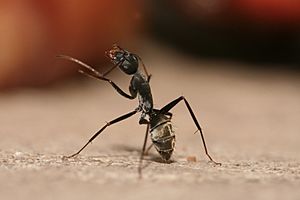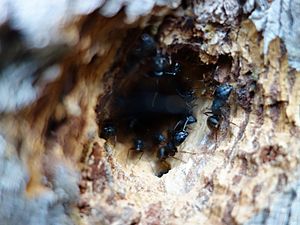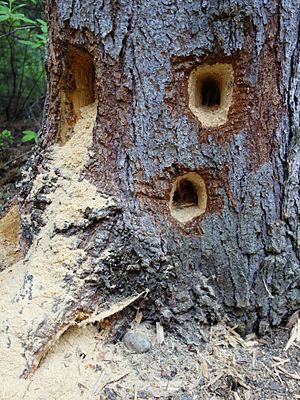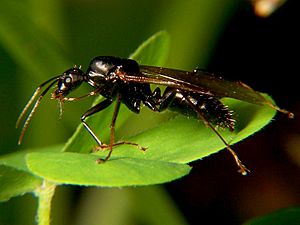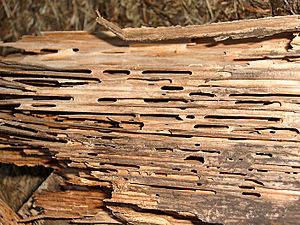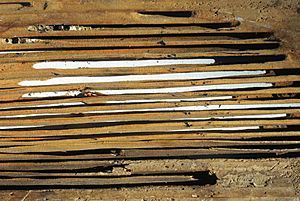Carpenter ant facts for kids
Quick facts for kids Carpenter ant |
|
|---|---|
 |
|
| A worker carpenter ant | |
| Scientific classification |
|
| Kingdom: | Animalia |
| Phylum: | Arthropoda |
| Class: | Insecta |
| Order: | Hymenoptera |
| Family: | Formicidae |
| Subfamily: | Formicinae |
| Tribe: | Camponotini |
| Genus: | Camponotus Mayr, 1861 |
| Type species | |
| Formica ligniperda Latreille, 1802
|
|
| Diversity | |
| > 1,000 species | |
| Synonyms | |
|
|
Carpenter ants (Camponotus species) are big ants, usually about 0.8 to 2.5 cm long. They live in forests all over the world.
These ants build their homes inside wood. They chew out tunnels and rooms using their strong jaws. They prefer wood that is dead and damp. Unlike termites, carpenter ants do not eat the wood. Instead, they push out a material that looks like sawdust. Sometimes, they make large hollow spaces inside trees. They can also make nests in wooden buildings. This can cause damage to homes. But in nature, their digging helps break down wood in forests. There are over 1,000 different kinds of carpenter ants. They also "farm" tiny insects called aphids. The ants protect the aphids. In return, the aphids give off a sweet liquid called honeydew. The ants get this honeydew by gently stroking the aphids with their antennae.
Where Carpenter Ants Live
Carpenter ants live both outside and inside. They like moist, rotting, or hollow wood. Forests are their most common home. They dig "galleries" or tunnels into the wood. These tunnels help them move around different parts of their nest. In houses, carpenter ants often infest areas with moisture. These include places around windows, under roofs, and on decks.

Some carpenter ants build long tunnels underground. These tunnels often lead to food sources. They might go to colonies of aphids. The ants then collect honeydew from the aphids. These tunnels can also be found inside trees. A carpenter ant colony usually has a main "parent" nest. This main nest is surrounded by smaller "satellite" nests.
What Carpenter Ants Eat
Carpenter ants are both hunters and scavengers. This means they eat parts of dead insects. They also eat sugary liquids from other insects or plants. Common foods include insect parts and "honeydew" from aphids. They also like nectar from plants. They will also eat other sweet liquids like honey or syrup. Carpenter ants can help aphids survive by taking care of them. They tend to many types of aphids.
Most carpenter ants look for food at night. They usually collect dead insects. Some types less often catch live insects. When they find a dead insect, workers surround it. They take its body fluids back to the nest. The hard outer shell is left behind. Sometimes, they bring the insect's head back. They also get the inner tissue from the head. Ants can look for food alone or in groups. They often choose to forage alone. Different colonies nearby might look for food in the same areas. But they usually do not help each other. Their main foods are proteins and carbohydrates.
When workers find food, they tell the rest of the nest. They use special chemicals called pheromones. These pheromones mark the shortest path from the nest to the food. When many workers follow this trail, the signal gets stronger. This creates a clear foraging trail. The trail stops when the food runs out. Workers feed the queen and young ants (larvae). They do this by eating the food and then spitting it up (trophallaxis) at the nest. Foraging trails can be above or below ground.
Carpenter ants are not usually very aggressive. But they have ways to get the most food. This happens when other animals visit the same food source. Sometimes, they build their nest near a steady food supply. More often, they visit the food source in an organized way. Different ants or groups take turns visiting. This makes it harder for other animals to get food. Other animals tend to visit randomly. The ants visit systematically. This helps them get more of the food. They visit areas with more food. This helps them leave less for others.
It is a common mistake to think carpenter ants eat wood. They actually cannot digest cellulose, which is what wood is made of. They only dig tunnels and nests inside it.
Ant Behavior and Life
Building Nests
Carpenter ants build their main nests where they lay eggs. These places usually have high humidity. This is because their eggs are sensitive to how much moisture is in the air. Once the main nest is set up, they build satellite nests. These satellite nests hold older young ants (larvae), pupae, and some winged ants. Only eggs, newly hatched larvae, workers, and the queen stay in the main nest. Satellite nests do not have sensitive eggs. So, ants can build them in many different places. These places can even be quite dry. Some species, like Camponotus vagus, build their nests in dry wood.
Mating Flight
When the weather is warm and humid, winged male and female ants fly out. This is called a nuptial flight. They come out of their satellite nests. The females mate with several males while flying. The males die after mating. These new queens then drop their wings. They look for new places to start a main nest. The queens build new nests and lay about 20 eggs. They care for these eggs as they grow. Worker ants eventually hatch. These workers help the queen care for more young ants. After a few years, new winged ants are born. These ants can start new colonies. Then, satellite nests will be built again, and the process repeats.
Ant Family Ties
Carpenter ants are social insects. This means they live in large groups. They are part of a group called hymenopterans. In these insects, sisters are more closely related to each other than to their own children. This is because of their special genetic system. This close relationship helps explain why they work together.
Recognizing Family
Carpenter ants, like many social insects, can tell who is from their nest. They can also tell who is not. This is important for how they act towards each other. For example, they might help family members more. They recognize each other mostly by chemicals. These chemicals include smells from their environment and special ant chemicals called pheromones. They also use "labels" from the queen. These labels are shared among all nest members. Ants can detect these chemical changes with their antennae. This helps them accept nestmates and reject outsiders.
For a carpenter ant to be recognized as a nestmate, it must interact with older ants. This happens when it is a young adult. This process also helps the ant recognize others. If these interactions do not happen early in adult life, the ant might not be recognized. It also might not be able to recognize its own nestmates.
Helping Each Other
Because they recognize family, carpenter ants show "kin altruism." Altruism means helping others, even if it costs you something. Carpenter ants help their nestmates. This helps their shared genes spread more easily. In many social insect species, worker ants cannot have babies. So, they give up having their own young. Instead, they help the fertile ants (like the queen) have babies.
Ant Communication
The queen ant greatly influences how individual ants interact. She uses special chemicals called pheromones. These pheromones can have different effects. Some pheromones can calm workers. Others can make them excited. Pheromones from queens laying eggs have a stronger effect. This is more than pheromones from queens who have not mated yet.
Colony Health
Social insects often have ways to fight off diseases. This is called "social immunity." Carpenter ants have this too. They share food by spitting it up (regurgitation). This spit can have substances that fight germs. These substances spread among the colony members. This sharing helps the whole colony stay healthy. It is very important when there are many diseases around.
Multiple Queens
Some social insect species have many queens. This is called polygyny. Carpenter ants are a bit different. They have several fertile queens. But these queens do not like each other very much. So, they spread out to different parts of the nest. Sometimes, queens will fight with other queens. But they usually do not fight through the workers. Queens become aggressive mainly if another queen enters their territory. Queens in a colony can work together to care for the young. Workers tend to survive better in colonies with more than one queen. However, some scientists still believe that most carpenter ant colonies have only one queen.
Exploding Ants
In Southeast Asia, there are at least nine types of carpenter ants called "exploding ants." One example is Camponotus saundersi. These worker ants have very large glands in their jaws. These glands run along their whole body. When in danger, they can explode themselves. They do this by rupturing their body. This sprays a toxic substance from their head. This is why they are called "exploding ants." The large gland makes a sticky glue. When it bursts out, the glue traps and stops any nearby enemies.
A type of termite called Globitermes sulphureus has a similar way to defend itself.
Selected Species
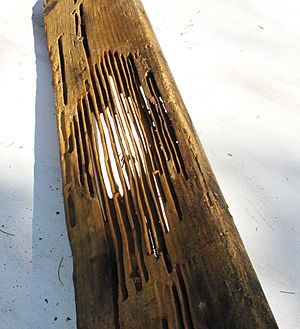
- Camponotus aeneopilosus – golden tail sugar ant
- Camponotus americanus
- Camponotus atriceps – Florida carpenter ant
- Camponotus chromaiodes – red carpenter ant
- Camponotus cinctellus – shiny sugar ant
- Camponotus consobrinus – banded sugar ant
- Camponotus detritus – Namib Desert dune ant
- Camponotus empedocles – glossy sugar ant
- Camponotus ferrugineus – red carpenter ant
- Camponotus floridanus, Florida carpenter ant
- Camponotus herculeanus – Hercules ant
- Camponotus japonicus – Japanese carpenter ant
- Camponotus ligniperda, a common species in Europe
- Camponotus modoc – western carpenter ant
- Camponotus nearcticus – smaller carpenter ant
- Camponotus nigriceps – black-headed sugar ant
- Camponotus novaeboracensis
- Camponotus pennsylvanicus – black carpenter ant
- Camponotus saundersi
- Camponotus schmitzi – diving ant
- Camponotus tortuganus – Tortugas carpenter ant
- Camponotus vagus
- Camponotus variegatus – Hawaiian carpenter ant
Carpenter Ants and People
One of the most common types of carpenter ants found near people in the United States is the black carpenter ant (Camponotus pennsylvanicus).
As Pests
Carpenter ants can damage the wood used to build houses. They leave behind a material that looks like sawdust. This material is called frass. It can help you find where their nest is. Carpenter ant tunnels are smooth. This is different from termite damage. Termites pack mud into their tunnels. Carpenter ants can be identified by a single spike-like bump on their "waist." This bump is between their chest and abdomen. To control them, people use insecticides. These can be dusts or liquids. Dusts are put directly into the tunnels where the ants live. Liquids are put in areas where ants might pick up the poison. They then spread it to the rest of the colony.
As Food

Carpenter ants and their young (larvae) are eaten in different parts of the world. In Australia, the Honeypot ant (Camponotus inflatus) is often eaten raw by Indigenous Australians. It is a favorite sweet treat for Aboriginal people in dry areas. They only dig up part of the nests. This helps keep the food source available for later. In North America, lumberjacks in Maine used to eat carpenter ants. This helped them avoid a sickness called scurvy. John Muir wrote that the Digger Indians of California ate the sour-tasting abdomens of large black carpenter ants. In Africa, carpenter ants are among the many insects eaten by the San people.
Images for kids
-
A winged Carpenter ant in West Bengal, India.
See also
 In Spanish: Camponotus para niños
In Spanish: Camponotus para niños


